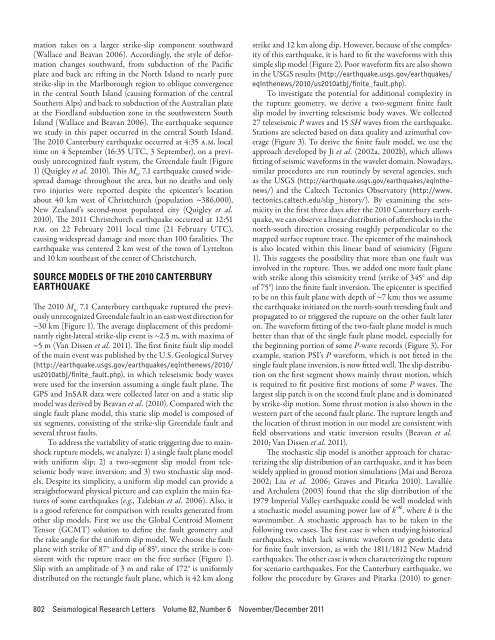Here - Stuff
Here - Stuff
Here - Stuff
You also want an ePaper? Increase the reach of your titles
YUMPU automatically turns print PDFs into web optimized ePapers that Google loves.
mation takes on a larger strike-slip component southward(Wallace and Beavan 2006). Accordingly, the style of deformationchanges southward, from subduction of the Pacificplate and back arc rifting in the North Island to nearly purestrike-slip in the Marlborough region to oblique convergencein the central South Island (causing formation of the centralSouthern Alps) and back to subduction of the Australian plateat the Fiordland subduction zone in the southwestern SouthIsland (Wallace and Beavan 2006). The earthquake sequencewe study in this paper occurred in the central South Island.The 2010 Canterbury earthquake occurred at 4:35 a.m. localtime on 4 September (16:35 UTC, 3 September), on a previouslyunrecognized fault system, the Greendale fault (Figure1) (Quigley et al. 2010). This M w 7.1 earthquake caused widespreaddamage throughout the area, but no deaths and onlytwo injuries were reported despite the epicenter’s locationabout 40 km west of Christchurch (population ~386,000),New Zealand’s second-most populated city (Quigley et al.2010). The 2011 Christchurch earthquake occurred at 12:51p.m. on 22 February 2011 local time (21 February UTC),causing widespread damage and more than 100 fatalities. Theearthquake was centered 2 km west of the town of Lytteltonand 10 km southeast of the center of Christchurch.SOURCE MODELS OF THE 2010 CANTERBURYEARTHQUAKEThe 2010 M w 7.1 Canterbury earthquake ruptured the previouslyunrecognized Greendale fault in an east-west direction for~30 km (Figure 1). The average displacement of this predominantlyright-lateral strike-slip event is ~2.5 m, with maxima of~5 m (Van Dissen et al. 2011). The first finite fault slip modelof the main event was published by the U.S. Geological Survey(http://earthquake.usgs.gov/earthquakes/eqinthenews/2010/us2010atbj/finite_fault.php), in which teleseismic body waveswere used for the inversion assuming a single fault plane. TheGPS and InSAR data were collected later on and a static slipmodel was derived by Beavan et al. (2010). Compared with thesingle fault plane model, this static slip model is composed ofsix segments, consisting of the strike-slip Greendale fault andseveral thrust faults.To address the variability of static triggering due to mainshockrupture models, we analyze: 1) a single fault plane modelwith uniform slip; 2) a two-segment slip model from teleseismicbody wave inversion; and 3) two stochastic slip models.Despite its simplicity, a uniform slip model can provide astraightforward physical picture and can explain the main featuresof some earthquakes (e.g., Talebian et al. 2006). Also, itis a good reference for comparison with results generated fromother slip models. First we use the Global Centroid MomentTensor (GCMT) solution to define the fault geometry andthe rake angle for the uniform slip model. We choose the faultplane with strike of 87° and dip of 85°, since the strike is consistentwith the rupture trace on the free surface (Figure 1).Slip with an amplitude of 3 m and rake of 172° is uniformlydistributed on the rectangle fault plane, which is 42 km alongstrike and 12 km along dip. However, because of the complexityof this earthquake, it is hard to fit the waveforms with thissimple slip model (Figure 2). Poor waveform fits are also shownin the USGS results (http://earthquake.usgs.gov/earthquakes/eqinthenews/2010/us2010atbj/finite_fault.php).To investigate the potential for additional complexity inthe rupture geometry, we derive a two-segment finite faultslip model by inverting teleseismic body waves. We collected27 teleseismic P waves and 15 SH waves from the earthquake.Stations are selected based on data quality and azimuthal coverage(Figure 3). To derive the finite fault model, we use theapproach developed by Ji et al. (2002a, 2002b), which allowsfitting of seismic waveforms in the wavelet domain. Nowadays,similar procedures are run routinely by several agencies, suchas the USGS (http://earthquake.usgs.gov/earthquakes/eqinthenews/)and the Caltech Tectonics Observatory (http://www.tectonics.caltech.edu/slip_history/). By examining the seismicityin the first three days after the 2010 Canterbury earthquake,we can observe a linear distribution of aftershocks in thenorth-south direction crossing roughly perpendicular to themapped surface rupture trace. The epicenter of the mainshockis also located within this linear band of seismicity (Figure1). This suggests the possibility that more than one fault wasinvolved in the rupture. Thus, we added one more fault planewith strike along this seismicity trend (strike of 345° and dipof 75°) into the finite fault inversion. The epicenter is specifiedto be on this fault plane with depth of ~7 km; thus we assumethe earthquake initiated on the north-south trending fault andpropagated to or triggered the rupture on the other fault lateron. The waveform fitting of the two-fault plane model is muchbetter than that of the single fault plane model, especially forthe beginning portion of some P-wave records (Figure 3). Forexample, station PSI’s P waveform, which is not fitted in thesingle fault plane inversion, is now fitted well. The slip distributionon the first segment shows mainly thrust motion, whichis required to fit positive first motions of some P waves. Thelargest slip patch is on the second fault plane and is dominatedby strike-slip motion. Some thrust motion is also shown in thewestern part of the second fault plane. The rupture length andthe location of thrust motion in our model are consistent withfield observations and static inversion results (Beavan et al.2010; Van Dissen et al. 2011).The stochastic slip model is another approach for characterizingthe slip distribution of an earthquake, and it has beenwidely applied in ground motion simulations (Mai and Beroza2002; Liu et al. 2006; Graves and Pitarka 2010). Lavalléeand Archuleta (2003) found that the slip distribution of the1979 Imperial Valley earthquake could be well modeled witha stochastic model assuming power law of k -n , where k is thewavenumber. A stochastic approach has to be taken in thefollowing two cases. The first case is when studying historicalearthquakes, which lack seismic waveform or geodetic datafor finite fault inversion, as with the 1811/1812 New Madridearthquakes. The other case is when characterizing the rupturefor scenario earthquakes. For the Canterbury earthquake, wefollow the procedure by Graves and Pitarka (2010) to gener-802 Seismological Research Letters Volume 82, Number 6 November/December 2011
















